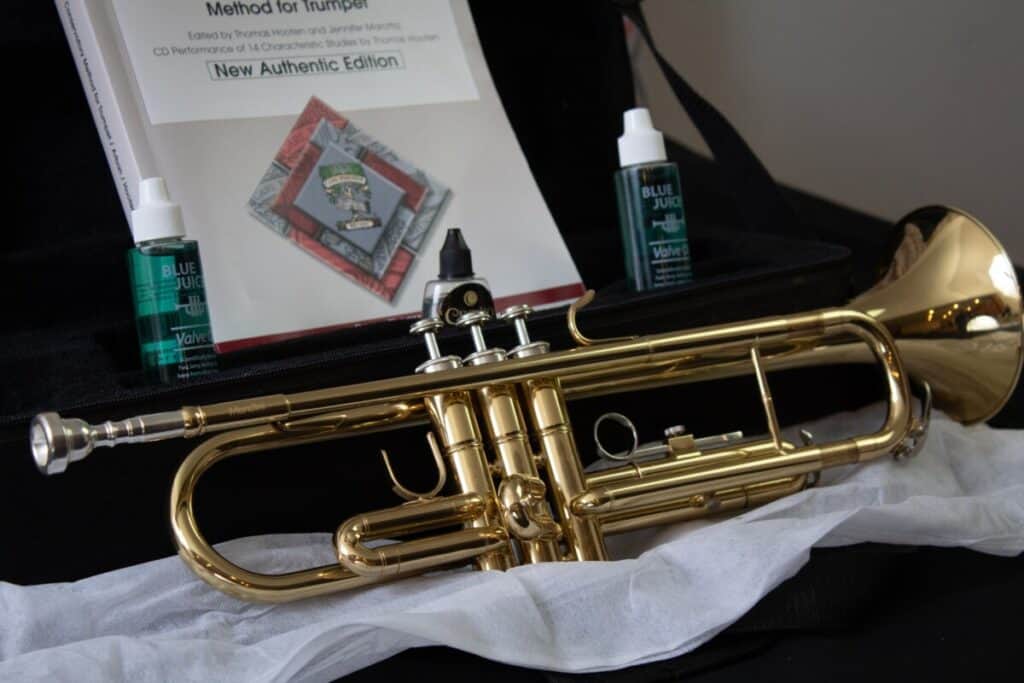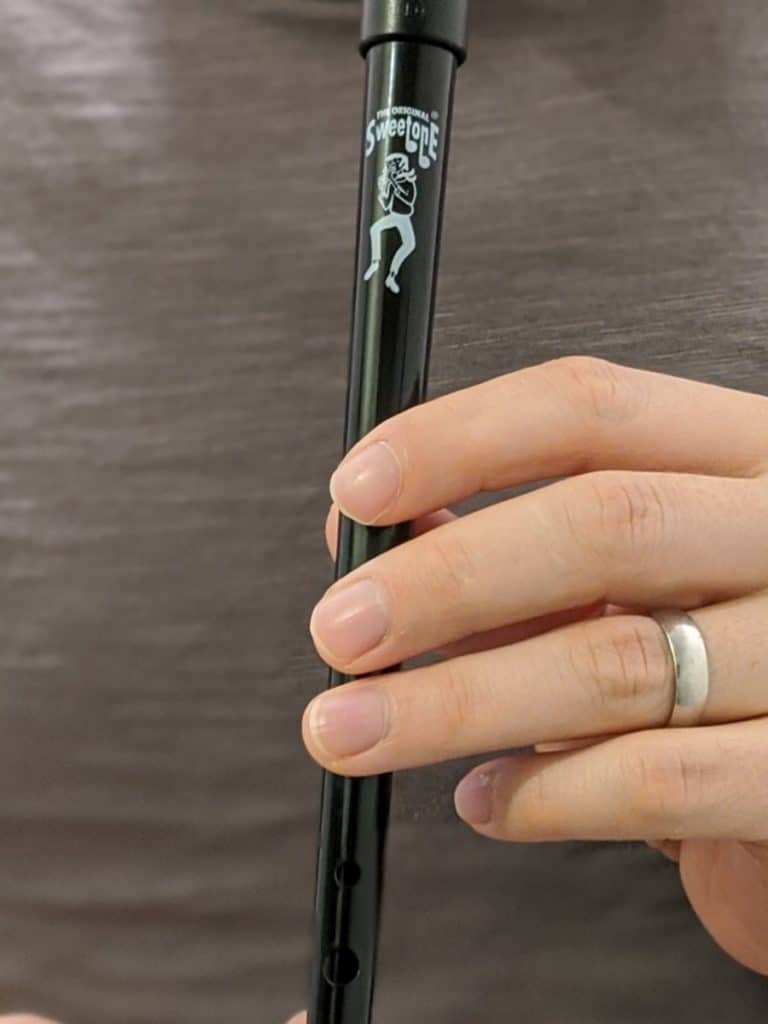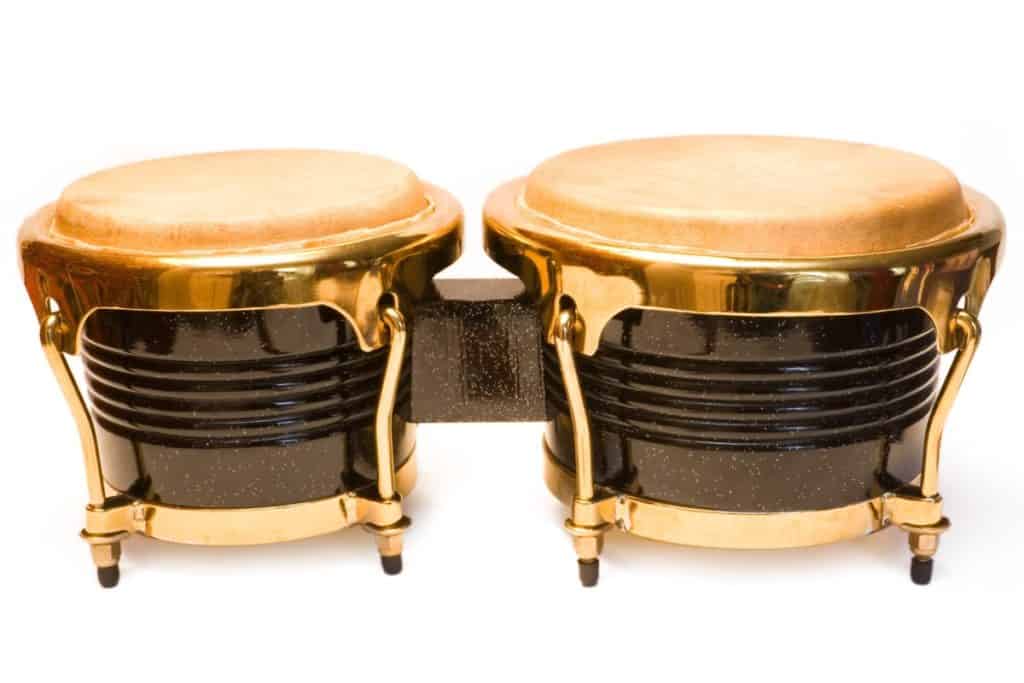This post contains affiliate links. We earn commissions if you purchase products from retailers after clicking on a link from our site. As an Amazon Associate, we earn from qualifying purchases.
Whether you’re a multi-instrumentalist, or whether you are looking for an instrument due to health reasons, or whether you are just curious–there are dozens of instruments that can be played with only one hand–some may even surprise you!
Melodic
By the way, looking for recording equipment and musical instruments? Check out Sweetwater.com for microphones, monitors, audio interface or any other recording gear that you could ever need. (Affiliate Link)
1. Harmonica (No Hands)
The harmonica is an instrument played by breathing through air holes which passes over a reed forming a sound.
The harmonica is in the rare-class of instrument that is hands-free if you have a harmonica stand. Bob Dylan, famous songwriter and singer, used a harmonica mount that rested on his shoulders and neck while he moved his head back and forth.
The harmonica mount is for those wanting to play guitar (or anything else, really), but you can easily play the harmonica while holding it with one hand.

You may see players use both hands to play,and that is simply to modulate and shape the sound.
One hand is being used to hold the harmonica in place and move it across your mouth, while the other hand is cupped over the sound holes of the harmonica–this hand can be used to alternate the sound between sounding full and thin which provides some interesting dynamics.
You can do the same with one hand if you have a harmonica mount–the possibilities are endless!
2. Trumpet
The trumpet, in the brass instrument family, is traditionally is meant to be held with the left hand and the valves are pushed with the other hand (although this can be different for a left-handed design). As any trumpet player knows, though, you can play with one hand by simply holding the instrument with the right hand and using the pinky finger and thumb to grip and hold the instrument while playing with the pointer, middle, and ring fingers.
There are many other options, too– players who have shoulder problems can use a trumpet mount that can attach to the trumpet to facilitate a weight and therefore pressure-free grip.
For normal playing, the trumpet is lightweight enough to be held and played with one hand.

Furthermore, plastic trumpets (such as the pTrumpet) have an incredibly good sound which most people can’t immediately tell the difference are even more lightweight, making these an excellent choice for one-handed playing.
You might be noticing there are two places for fingers, one for the right pinky finger and another for the left ring finger. Technically, many professional musicians will adjust one of the valves as they play to prevent a couple out-of-tune notes, but this is an advanced technique that isn’t necessary and there are other ways to get around this problem that shouldn’t hinder you. (I’ve heard of a device that could adjust this valve with a thumb button so everything could be done with one hand)
One common myth people have is that because the trumpet has 3 valves that it is easier to play than other instruments. This couldn’t be further from the truth. The trumpet is actually a difficult instrument to learn because the sound is only shaped by the valves, but the actual sound is emanating from the players lips (which shape and form is called the embouchure).
What I’m getting at here is that the trumpet is a serious instrument and requires constant practice to maintain the fragile embouchure. If you are looking for an instrument that can easily sustain a music career that is also playable with one hand with no limitations, than trumpet is worthy of thinking about.
3. Trombone
Man, I love the sound of the trombone, it’s such a rich and powerful sound!
A trombone is a brass instrument that is played by adjusting the length of the tubing by pushing and pulling a slide.
The trombone is designed to be held with one hand, and then played with the other, but that doesn’t mean you can’t play with one hand.
Because of the weight of the instrument, the stand solution needs to be more robust, but if you are able to suspend the instrument solidly, you can play the trombone without limitation with one hand, since the entire instrument is controlled by that slide.
Furthermore, there are plastic versions of the trombone, making this process easier and even more accessible.
4. Melodica
The Melodica is an incredible and simple to play instrument–it captures the incredible dynamics of the breath while allowing the shaping of the sound by depressing the keys. It’s traditionally played by holding the instrument with one hand, blowing into the instrument, and pressing the keys with the other hand.
However, a common attachment for the melodica is a tube that can be attached to the mouthpiece that allows this instrument to lay flat while you blow into it from a greater distance.
This is commonly a learners instrument due to its straightforwardness, but you’ll hear the melodica in lots of popular music.
5. Kalimba (Thumb Piano)
The Kalimba is one of those famous instruments that everyone has heard in movies and in music but that nobody has seen much of. It’s a quiet, beautiful instrument that doesn’t beg you of your attention.
The kalimba is composed of metal tines that are tuned to particular notes. To play, you simply pluck the tines with your fingers/fingernails. The tines are mounted onto a sounding box/board. Often the box has a sound hole (like a guitar) facing the player.
For the most part, the kalimba is played with the player’s thumbs or fingers.
The kalimba comes in hundreds of variations. You may also see this instrument as a Mbira–which comes in hundreds more variations.
Some kalimbas have more or less tines, others are in different shapes and sizes.
In particular, there are kalimbas that are easier to play with one hand. My kalimba comes in a fairly common variety of 17 notes. It’s definitely possibly to play with one hand, but it’s shaped in such a way to make this require extra coordination.
Kalimbas such as this one on Amazon (Amazon) has 7 tines, which means it can play 7 notes. That’s enough to play all the notes of a major scale. These types of kalimbas are easy to play with one hand since the playing field of the instrument is smaller, but you can still play all the notes of a major scale. Kalimbas also come in 7,8, and 10 note variations, to name a few. Kalimbas with 10 tines or less are convenient for playing with one hand.
6. Lap Harp / Music Maker (Type of Zither)
A traditional zither is meant to be played with two hands, but it can be played with one hand. A simpler instrument that is similar to the zither in concept but has a smaller range and is designed more for one-handed playing is the lap harp. This particular design is named the Music Maker.
Lap Harp demo:
The lap harp was designed for beginner musicians in mind since it is specially shaped to fit a special tablature (a “tab” is a type of music notation specific to an instrument for easier reading), which linens up the notes with the harp strings.
In other words, simply by “connecting the dots” you can make a song as is shown in the video above.
The lap harp is compact enough to be comfortably played with one hand.
7. Pan Flute
Remember the old 1950’s Peter Pan cartoon? Peter had his own instrument which is a type of flute called a pan flute. A pan flute is a type of flute where tubes of ascending length are arranged side by side. The instrument is played similar to a concert flute (or a coke bottle) where you blow over the pipe towards the lip on the opposite end of the pipe. To change pitches, you blow over a different pipe.
The pan pipe has what some call an ethnic feel, and is often mentally associated with ancient South American cultures.
The pan flute is mechanically played similarly to the harmonica where one hand is used to hold and stabilize the flute and you move the instrument left and right to different tubes to change pitches.
Pan flutes come in different sizes–some of them are more compact and are ideal for playing with one hand, while others are larger and are more convenient to play with two hands.
8. Tin Whistle
The Tin Whistle is a fipple flute that is played by blowing into a mouthpiece and out comes the sound. It’s much easier to make a sound than than a concert flute (where you blow over a sound hole).
Quick plug for tin whistles–I love this instrument. It has a sweet and beautiful sound that many movies capitalize on, even though most people aren’t aware of it.
This is a traditionally two-handed instrument, but it can be played, and played competently with only one hand. It’s more possible than for many other types of flutes because the tin whistle only has 6 holes (and only is meant for 7 notes), and so is a relatively more simple instrument.

Don’t believe me? Check out Jean Duval, who arranged 12 suites of songs to be specifically played with only one hand. The greatest drawback is that there are two notes that are virtually impossible to play without two hands.
9. Keyboard / Synthesizer
Notice I’m not saying piano–while piano can be played with one-hand, certainly, you’re not reaching near the capacity of the instrument with one hand. However, that’s because of the way the piano was designed. Keyboards and other synthesizers are shaped like piano keyboards, but represent any imaginable instrument.
Keyboards are often played with one hand because they are assigned to sounds that sound better with only a few notes at a time, such as pads, or synth leads such as a sawtooth waveform synth.
For this reason, many keyboards / synthesizers don’t have 88 keys like a traditional piano, but are half, or even a quarter of the size of a piano.
There is really no limit when it comes to a keyboard synthesizer as to what sounds you can make and control.
10. Tabor Pipe (3-hole pipe)
If you look up the word “tabor” you’ll find that it just means drum. How is a drum in this category? Well, it’s not really–but this pipe was often combined with this drum to the point where it’s often called a tabor pipe.
This is an ancient, but beautiful flute with a medieval sound. This particular instrument was made for multi-instrumentalists and can therefore be played fully with just one hand.
The tabor pipe is not a common instrument–but there are still manufacturers that produce them. If you’re looking for an instrument to grab attention and try something unique, it’s a fantastic option.
Even as I write this, it makes me want to try one. Here you can find some at Susato.
Synthesizers
Synthesizers are somewhere between melodic and percussion instruments because they are capable of both!
11. Orba
This is an extremely compact portable synthesizer that is designed for expressiveness. Rather than just pushing buttons, you can use its built-in accelerometers by rocking the instrument to modulate the sound (for glissandos and anything else you want).
Since it’s a synthesizer, you can play drums, pads, lead synths, traditional (but synthesized) instruments like brass or piano, etc.
I have over 12 instruments in my house–and the more I research this one, the more I want it. The ability to make entire jams using its looping technology means that it’s a robust and powerful instrument in its own right.
Because it’s small, what’s exciting about this is that it is compact enough to be played with one hand. It will require practice and coordination to perform some of the gestures while playing, but because of its robustness you won’t likely feel limited–at least from my outsider eyes looking in.
Anyway, you can find them at Artiphon’s shop (the makers) here.
12. Jammboxx
The Jammboxx is another synthesizer that takes after the design of a harmonica. Because of its design it can be played with no hands if you have a stand. In fact, it is marketed particularly to players with mechanical limitations.
It’s worth noting that the Jammboxx doesn’t make sound on its own, it’s a MIDI controller that must be attached to a computer and speakers to make sound. This gives it maximum flexibility in that you can play any digital instrument possible.
Even if you hold the instrument or play it on the stand, this instrument makes it possible to play a dynamic range of music with one hand.
13. Drum Machine
Drum machines are sampled with drums–so instead of playing a drumset with all limbs, you can build a pattern slowly with your fingers as this gentleman does in this video with the vintage Yamaha RX11:
With some coordination, you can build some incredible rhythms. This is definitely possible to use with one hand although it may require some additional one-hand coordination. The fact that you can build onto loops cumulatively means you don’t have to create your beats all at once. This makes drum machines like this one an excellent option for those wanting to play with one-hand.
Percussion
14. Didgeridoo (No-Hands)
The didgeridoo is an ancient instrument that originates from the aborigines in Australia.
The didgeridoo is essentially a hollow cylinder that the player buzzes their lips into one end. Although this sounds very simple, the didgeridoo is capable of an incredible range of sound.
Some wooden didgeridoos are often very heavy, and players actually don’t play them while holding the entire instrument. Often players will play in a seated position while the opposite end of the instrument is resting on the ground. Serious players can get a stand which can suspend the didgeridoo and allow the player to play, even without any hands.
If you don’t think it’s possible to play the didgeridoo and anything else, check out Xavier Rudd here:
Mind-blowing, right?
The didgeridoo is a simple instrument with depth that can be a rewarding venture for years. No hands required!
15. Shakers / Maracas / Tambourines
These are instruments that don’t get a lot of attention because they are considered auxiliary instruments. In other words, in most bands, the lead guitarist isn’t likely to hand it over to the tambourine player for a solo.
The concept of all of these percussion instruments is that if you shake the instrument, it makes sound.
This doesn’t mean that there is not an incredible amount of skill involved with serious auxiliary percussionists. Keeping rock-solid beats takes ages of practice. Shakers require tight and consistent coordination.
That video is just a small example of how shaker coordination can approach the next level. To reach this level of skill requires countless hours of practice.
If you want to feel locked in with the music you’re playing with, these types of percussion are accessible to anyone who can tap their foot to a beat. If you pursue the instrument, there are hidden depths to these types of instruments.
16. Drumkit
So, when you try to think about one-handed instruments, usually drums don’t come to mind, but the advantage of drums is that you can play incredible beats with just 3 limbs. That’s 3 different opportunities to make a sound with the instrument. Some one-handed drummers find other ways to add a 4th limb in there such as with this video:
But even if that’s not an option for you, you can accompany most rock songs you hear comfortably with only one hand. You will have to learn some additional coordination with your two feet, but many drummers focus on these areas even with the use of all 4 limbs because there is so much potential.
17. Bongos
Bongos and other hand drums (such as congas) are drums with exposed bearing edges (check out our article that talks exactly about how bongos are constructed, here). What this means is that they are designed to be played with your hand instead of a drumstick.

I’ll be honest, having two hands helps with all these instruments, but you really can do a lot with one hand–although it will require extra work to increase your finger dexterity if you want to accomplish more complex sounds such as rolls.
You can however, bundle other instruments with one hand to increase the variety of the sound. For example, in my video here I demonstrate rhythms while holding an egg shaker:
There is a lot you can do, but you might have challenges reaching the full potential for the instrument–but still an option for plenty of rhythms on the bongos for one-handed playing.
18. Bones
Bones are two curved pieces of wood (or ribs of a cow) that are played by twisting the wrist to produce a clacking sound. These are very impressive to watch and listen to.
Although the instrument is simple, it’s darn tricky to figure out! You may have to practice for several hours before you can get the “triplet”.
Although you can play with two sets of bones, there is not a strict reason to, it just adds the ability to have more complex rhythms. However, there’s plenty you can do with just one set.
19. Beatboxing (No Hands)
Beatboxing is essentially creating rhythms with sounds from your mouth and is hands-free.
Beatboxing is a little non-obvious and may be overlooked. It’s not something you’re born with either–incredible beatboxing requires incredible practice.
Beatboxing is a fun hobby if nothing else and is accessible to most everyone.
